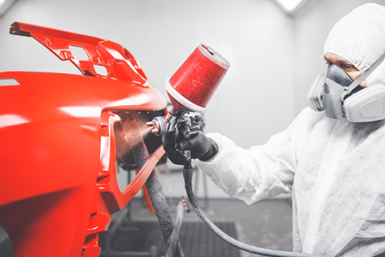Troubleshooting the Drying Process
For some technicians who are new to spraying water coatings, it can be a huge learning curve, as the basics of reduction, spraying and drying are much different than those of the solvent world.
When it comes to finishing, waterborne coatings have become the new standard in some industries. For years, paint manufacturers have focused on improving technology, including basic application, color match and drying. In collision shops, color match is the most crucial and stressful to the painters themselves. However, the dry time is often the most difficult part, especially when spraying in hot, humid climates.
For some technicians who are new to spraying water coatings, it can be a huge learning curve, as the basics of reduction, spraying and drying are much different than those of the solvent world. You are not spraying per temperature as much as you are spraying per humidity level. Therefore, you are not drying via temperature for solvent evacuation but drying by dehydrating the surface via air movement. For water systems especially, this is why the viscosity of each mix is so important. The same disaster of solvent entrapment can be replicated even worse by having a still-hydrated coating underneath. Solvents will eventually work themselves out of the layers; water will not.
Finding the right air movement
To remedy the air movement needed, air blowers were introduced and have been refined over the years. The introduction of blowers into a booth can be tricky for some painters as they do not understand how to position them for efficiency. The entire purpose of blowers in the booth is to make the air turbulent for the coating to properly dehydrate. How does this happen exactly, though? Let’s use the popular downdraft booth as an example. By design, a downdraft booth doesn’t have (much) turbulent air, and most are laminar air. This means the air flows in a straight line from the upper plenum through the ceiling filters, down around the vehicle and then through the exhaust. How exactly do blowers cause turbulent air? Aren’t they just blowing air? Not exactly. Let’s work through the different styles of blowers because each is important to understand.
Wall-mounted blowers
Wall-mounted horizontal blowers move air in a conical shape through the many openings toward the vehicle, breaking up the laminar air from the booth. The goal of having turbulent air is to not only “blow” across a panel, but rather help “pull” the water out of the coating as it goes across. Wall-

mounted blowers, as well as booths that have increased air speed and heat, do a great job of drying out the panels of a freshly coated vehicle. But what about the sides of said vehicle? What if the booth doesn’t dry the sides as well?
Handheld blowers
Handheld blowers are what a painter will find for single-spot use or mounting on a stand and do a great job of positioning. They sport a venturi-style make up to spin the air out toward a panel and help introduce the turbulence needed for drying. However, the venturi style helps pull air from the rear of the setup, and many painters (when using by hand) do not hold the device far enough away from themselves to generate the airflow needed. In turn, debris is pulling off the painter, sending it flying into the paint job they are trying to complete. Others will see this and try to crank the PSI at the wall to the unit, supplying too much air to the device, which over-pressurizes it, not enabling it to create the airflow vortex needed to properly do its job.
Final thoughts
What about positioning? There can be several big problems that arise from poor positioning of added blowers, whether they be wall-mounted, stand-mounted or handheld. The most basic one of all comes from pointing across a panel toward the floors or walls, and not directly toward the panels or even slightly above. Often, veteran painters complain of trash issues in their paint jobs, only to find their blowers are stirring up dirt from the floor, which eventually lands in their paintwork. Turbulent air is a good thing on the panel to help dry, but not so much when it is on the floor of a booth and kicking up debris.
Too much air can cause issues elsewhere in the booth causing unwanted turbulence. The idea is for it to be controlled chaos when drying a coating and not to feel as if the entire room is a hurricane.
Filtration is just as important when it comes to drying water systems as it directly involves booth pressure. If the booth filters are loading up, the result will be the pressure in the booth beginning to rise, not enabling proper airflow. What happens when air is introduced into a booth and cannot escape? It becomes turbulent along the walls and floor, which kicks up debris. All the while you are trying to dry a paint system with blowers up high.
About the Author
Jeremy Winters
Jeremy Winters is a marketing and content creator for Accudraft PaintBooths. Visit accudraftpaintbooths.com.
Related Content
Adjusting Current and Voltage When Powder Coating
Which manual powder coating gun setting is better to adjust, voltage or current? Jeff Hale of Gema USA discusses when to use different settings on your powder gun to achieve optimal results.
Read MoreHow to Address Declining Powder Coating Coverage Over Time
Fine particles from reclaim could be to blame for powder coating problems that emerge over time. Avoid problems by keeping hooks clean, maintaining guns and using reclaim powder quickly to avoid accumulation of fines.
Read More10 Anodizing Best Practices
Following this list of guidelines can help to increase the performance, cost effectiveness and quality for your anodizing operation.
Read MoreUnderstanding and Managing White Spots on Anodized Aluminum
Having trouble with spotting defects when anodizing? Taj Patel of Techevon LLC offers a helpful overview of the various causes of white spots and potential solutions.
Read MoreRead Next
The Best Method for Coating Full-Size Aircraft
John Owed from Carlisle Fluid Technologies analyzes the difference between using air-assisted airless, air spray and other technologies for coating a full-size aircraft. Which is better?
Read MoreThe Positive (and Negative) On Airflow
Jeremy Winters of Accudraft Paint Booths shares how solvent and water-based coatings are affected by a paint booth’s airflow.
Read MoreEducation Bringing Cleaning to Machining
Debuting new speakers and cleaning technology content during this half-day workshop co-located with IMTS 2024.
Read More














.jpg;maxWidth=300;quality=90)







